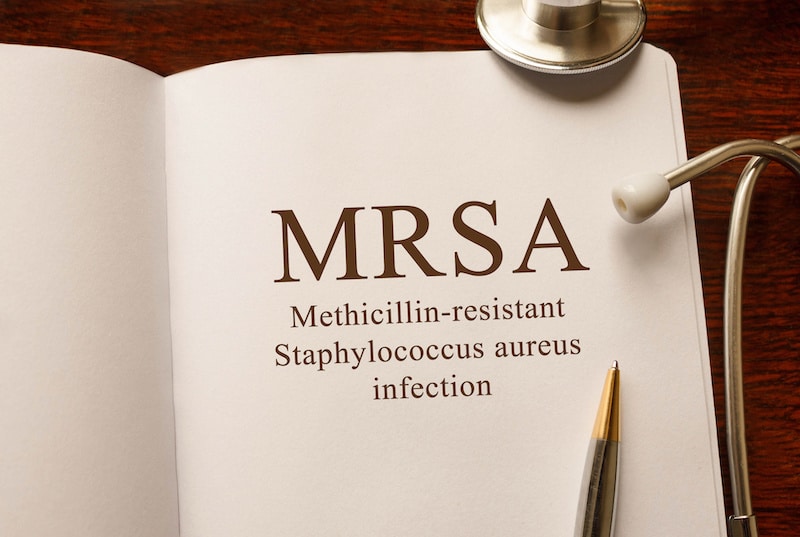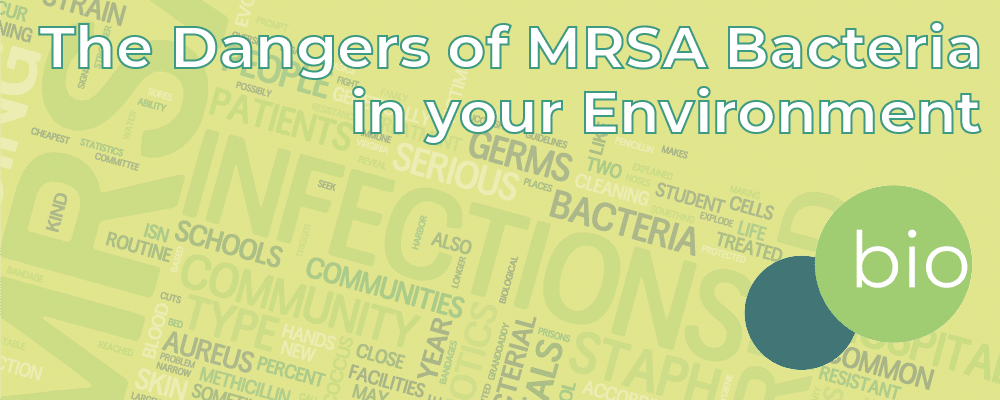There are good bacteria, and there are bad bacteria. And then, there’s the MRSA Infection.
What we refer to as “Staph” bacteria isn’t uncommon. It inhabits the upper respiratory tracts (most frequently, inside the nostrils) of roughly 30% of healthy humans, and like many other bacteria species, it’s often found living on the surface of our skin. But when we have scrapes, cuts or a respiratory issue, Staphylococcus aureus can cause pneumonia and serious infections in blood, bone, organs, and tissues.
A growing number of Staph bacteria strains are resistant to front-line antibiotics, including methicillin; when they take over, what might otherwise be a minor infection can become a life-threatening emergency.

What is MRSA Infection?
MRSA stands for Methicillin-resistant Staphylococcus aureus; these bacteria have, over time, mutated to survive essential category of antibiotics doctors rely upon to combat a bacterial disease. There are three main MRSA types, each closely related but genetically distinct from one another:
- Healthcare-acquired MRSA (HA-MRSA): First recognized in the 1960s, though penicillin-resistant bacteria were well-known prior to then. Surgical patients, particularly those receiving implants or undergoing heart surgery, are at higher risk.
- Community-acquired (CA-MRSA): Defined in the 1990s, referring to MRSA found anywhere outside medical facilities.
- Livestock-acquired (LA-MRSA): Typically found in livestock handling facilities and kennels, it’s often found in nasal swabs of humans working in these settings. While people can transfer this strain to animals and vice-versa, the bacteria don’t adapt well outside this environment.
Not all S. aureus strains are antibiotic-resistant, but if left unchecked, they can cause serious infections such as cellulitis, toxic shock syndrome, food poisoning, and sepsis. Infections may occur in skin wounds, blood, organs, and bone. Even when caught early, some antibiotic-resistant infections don’t respond at all to available treatment, leading to the patient’s death.
How Do You Get MRSA?
Staph bacteria prefer warm, moist environments, and it thrives on the insides of elbows and knees, in armpits, in the groin area, nostrils, and in skin folds. It also thrives in damp, dirty clothing. The CDC recommends washing sweaty work and gym clothes in between every use, bathing regularly, minimizing hand-to-nose contact, and frequent hand-washing. Avoid sharing towels, razors, and unsterilized manicure sets, and wash your hands regularly.
In spite of MRSAs preference for warm and humid host environments, it survives longer on hard surfaces than many other pathogens, increasing the risk of cross-contamination for several weeks. Think of where hands frequently come in contact with surfaces shared by potentially-infected people:
- Doorknobs and handles
- Sink faucets and flush levers
- Computer keyboards
- Remote controls
- Elevator buttons
- Gym equipment
- Childrens’ toys
- Shopping carts
- Bowling balls
- Showers
- Untreated water
If you have an open cut or scrape, your chances of infection are much higher than without. Keep all wounds clean and covered with a bandage, and prevent touching your eyes, nose, or mouth after handling potentially contaminated objects.
Wash your hands after having skin-to-skin contact with people suspected of having a bacterial infection. This always good practice anyway, as many other viral and bacterial illnesses also spread by similar means.
Our Experience With The MRSA Infection

Hospitals, surgical facilities, and prisons are prone to MRSA infection outbreaks, and we frequently contract with administrators to conduct top-down decontamination services. We also sanitize ambulances and police vehicle after potential exposure, which is always a risk when transporting patients or detainees with infected sores or signs of septic shock.
On one notable occasion that illustrates a “worst-case scenario”, we were called to decontaminate a residence after an individual died of a severe septic infection. We cleaned and sanitized a bedroom, hallway, and bathroom after a very large septic boil burst, spilling a large volume of blood and pus. The project required removal of solid and liquid biohazardous contaminants in the affected area, as well as sanitization of any other surfaces the decedent may have touched since acquiring the wound.
As with antibiotics, bacteria can become resistant to antimicrobial products. We use CDC-recommended, effective cleaning products and protocols to ensure neutralization of MRSA Infection bacteria without resorting to “the last line of defense” chemicals to which bacteria might become resistant. At the same time, we ensure that affected environments are clean, safe, and free of toxic cleaning residue and fumes.
Biohazard cleaners are always necessary, whether it’s anywhere from determining the cleanup of cold vs flu, MRSA vs C. Diff, or HIV vs hepatitis, or the full on cleaning needed for these infectious diseases.
Learn more about our disease cleaning services, which also include cleaning after death, and bloodborne pathogen decontamination, and neutralization of pervasive odors. We’re available 24/7 to serve private, industrial, commercial, and institutional clients anytime there’s a need for discreet, OSHA-compliant sanitation services.
We can help you put a plan in place should a MRSA Infection outbreak occur, and we’re ready should you be experiencing a crisis today.
